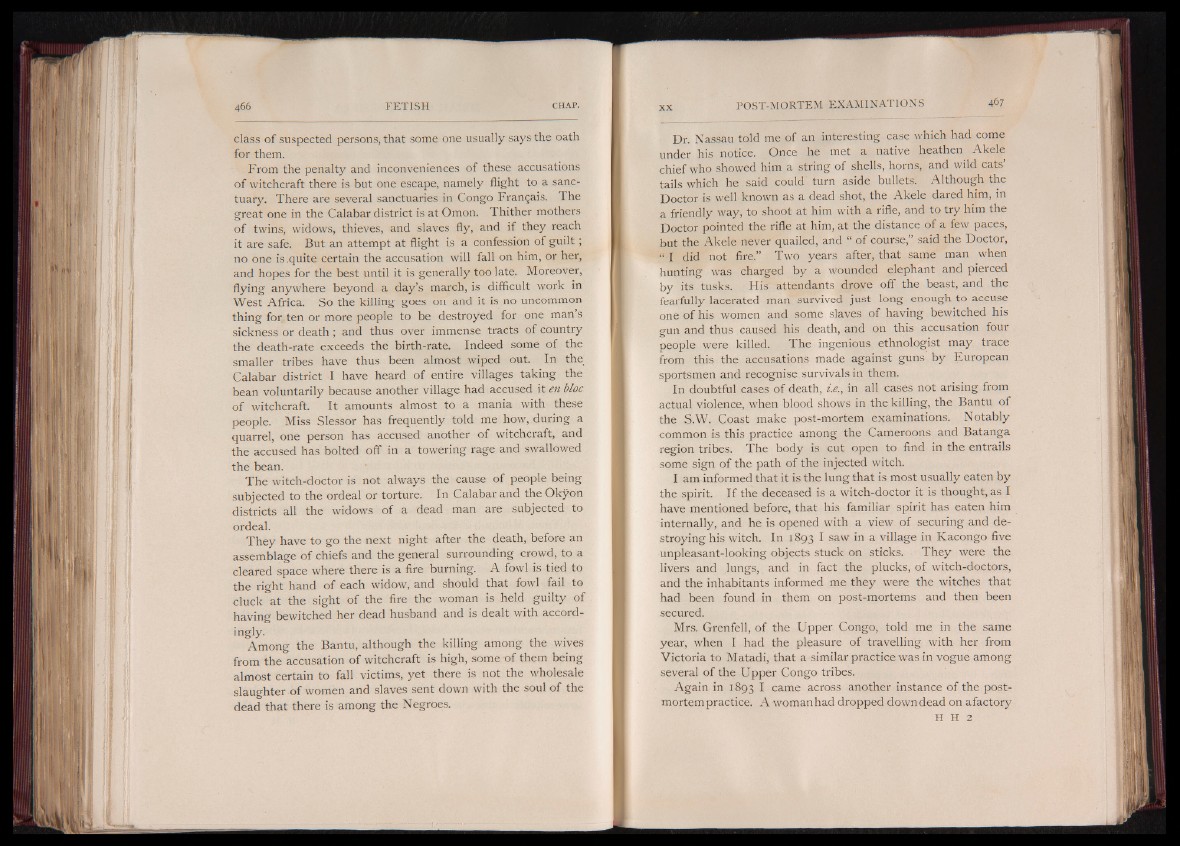
class of suspected persons, that some one usually says the oath
for them.
From the penalty and inconveniences of these accusations
of witchcraft there is but one escape, namely flight to a sanctuary.
There are several sanctuaries in Congo Français. The
great one in the Calabar district is at Omon. Thither mothers
of twins, widows, thieves, and slaves fly, and if they reach
it are safe. But an attempt at flight is a confession of guilt ;
no one is .quite certain the accusation will fall on him, or her,
and hopes for the best until it is generally too late. Moreover,
flying anywhere beyond a day’s march, is difficult work in
West Africa. So the killing goes on and it is no uncommon
thing for ten or more people to be destroyed for one mans
sickness or death ; and thus over immense tracts of country
the death-rate exceeds the birth-rate. Indeed some of the
smaller tribes have thus been almost wiped out. In the
Calabar district I have heard of entire villages taking the
bean voluntarily because another village had accused it en bloc
of witchcraft. It amounts almost to a mania with these
people. Miss Slessor has frequently told me how, during a
quarrel, one person has accused another of witchcraft, and
the accused has bolted off in a towering rage and swallowed
the bean.
The witch-doctor is not always the cause of people being
subjected to the ordeal or torture. In Calabar and the Okÿon
districts all the widows of a dead man are subjected to
ordeal.
They have to go the next night after the death, before an
assemblage of chiefs and the general surrounding crowd, to a
cleared space where there is a fire burning. A fowl is tied to
the right hand of each widow, and should that fowl fail to
cluck at the sight of the fire the woman is held guilty of
having bewitched her dead husband and is dealt with accord-
ingly.
Among the Bantu, although the killing among the wives
from the accusation of witchcraft is high, some of them being
almost certain to fall victims, yet there is not the wholesale
s l a u g h t e r of women and slaves sent down with the soul of the
dead that there is among the Negroes.
Dr. Nassau told me of an interesting case which had come
under his notice. Once he met a native heathen Akele
chief who showed him a string of shells, horns, and wild cats’
tails which he said could turn aside bullets. Although the
Doctor is well known as a dead shot, the Akele dared him, in
a friendly way, to shoot at him with a rifle, and to try him the
Doctor pointed the rifle at him, at the distance of a few paces,
but the Akele never quailed, and “ of course,” said the Doctor,
“ I did not fire.” Two years after, that same man when
hunting was charged by a wounded elephant and pierced
by its tusks. His attendants drove off the beast, and the
fearfully lacerated man survived just long enough to accuse
one of his women and some slaves of having bewitched his
gun and thus caused his death, and on this accusation four
people were killed. The ingenious ethnologist may trace
from this the accusations made against guns by European
sportsmen and recognise survivals in them.
In doubtful cases of death, i.e., in all cases not arising from
actual violence, when blood shows in the killing, the Bantu of
the S.W. Coast make post-mortem examinations. Notably
common is this practice among the Cameroons and Batanga
region tribes. The body is cut open to find in the entrails
some sign of the path of the injected witch.
I am informed that it is the lung that is most usually eaten by
the spirit. If the deceased is a witch-doctor it is thought, as I
have mentioned before, that his familiar spirit has eaten him
internally, and he is opened with a view of securing and destroying
his witch. In 1893 I saw in a village in Kacongo five
unpleasant-looking objects stuck on sticks. They were the
livers and lungs, and in fact the plucks, of witch-doctors,
and the inhabitants informed me they were the witches that
had been found in them on post-mortems and then been
secured.
Mrs. Grenfell, of the Upper Congo, told me in the same
year, when I had the pleasure of travelling with her from
Victoria to Matadi, that a similar practice was in vogue among
several of the Upper Congo tribes.
Again in 1893 I came across another instance of the postmortem
practice. A woman had dropped down dead on afactory
H H 2